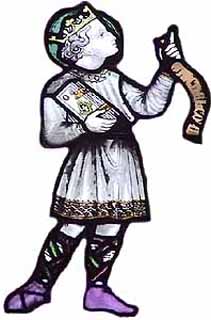
EBK Home
Kingdoms
Royalty
Saints
Pedigrees
Archaeology
King Arthur
Mail David
 St.
Cenelm,
King of Mercia
St.
Cenelm,
King of Mercia(AD 814-821)
In AD 821, King Cenwulf of Mercia died at Basingwerk, while campaigning against the Welsh of Powys. He left two daughters, Cwendreda and Burgenhilda, and a son, a child of seven years old, named
Cenelm or, more commonly these days, Cenelm, who was chosen to succeed him. Cwendreda envied her little brother and thought that, if he were killed, she might reign as Queen. She therefore conspired with her lover, Askbert, who was her brother's tutor and guardian, and gave him money, saying, "Slay my brother for me, that I may reign." Burgenilda was not privy to this wicked deed, however, for she loved her little brother.
So, on 3rd November, Ascbert took Cenelm out into the Forests of Worcestershire on a hunting trip. After the exertions of the chase, the young lad soon tired with the heat, and decided to lay down under a tree for a nap.
Ascbert, meanwhile, began to dig a grave; but the boy suddenly awoke and admonished him, "You think to kill me here in vain, for I shall be slain in another spot. In token, thereof, see this rod blossom." And he thrust a stick into the ground, which instantly took root and began to flower. It grew, in years after, to be a great ash tree, which was known as St.
Kenelm's Ash. Unperturbed, Askbert took the little King further into the forest and up to the Clent Hills, to Romsley (Worcs), where the child began to sing the "Te Deum," the assassin smote his head clean off; and then he buried him in the thicket.
Now, at the same time, a white dove is said to have flown into the church of St. Peter in Rome, with a letter in its beak which it deposited on the high altar. And men took the letter and tried to read, but they could not make it out, for it was written in English. At last, an Englishman was found, however, and he read the letter. It stated that
Cenelm, the little King of the Mercians, had been cruelly murdered and his body hidden in a thicket.
So the Pope wrote letters to the kings of the English and told them what an evil deed had been done in their land, and men went forth to seek the body. As they went, they saw a pillar of light shining over a thicket in Worcestershire and, there, they found the body of
Cenelm. They carried him to the Royal Mercian Abbey at Winchcombe, in Gloucestershire, where he was
buried with all honour and revered as a martyr. But over the place where they found his body, they built a little chapel. Today it is the Church of St.
Cenelm at Romsley in the Clent Hills.
The story of Cenelm appears to bear little relation to the known facts about him. Somewhat older than seven, he signed a number of his father's charters between AD 798 & 811, he owned land in Glastonbury (Somerset) and is thought to have died, fighting the Welsh, in AD 812. In an interesting twist, however, local historian, Roger Chambers, suggests that there were two
Cenelm half-brothers, one named after the other, and that this may have been the elder of the two;
Cenelm the younger being the Saint of popular legend. His feast day is celebrated on 17th July, the date of his translation to Winchcombe.
